This Alphabet (Google) SWOT analysis reveals how one of the most successful internet companies used its competitive advantages to dominate digital advertising industry.
It identifies all the key strengths, weaknesses, opportunities and threats that affect the company the most. If you want to find out more about the SWOT of Alphabet (Google), you’re in the right place.
For more information on how to do a SWOT analysis please refer to our article.
Keep reading.
Company Overview
| Name | Alphabet Inc. |
|---|---|
| Founded | October 2, 2015 (Google founded in September 4, 1998) |
| Logo |  |
| Industries served | Internet (Google Search, Google Ads, Gmail, YouTube) Computer software (Android, Chrome) Consumer electronics (Chromecast, Google TV, Pixel) Venture Capital (CapitalG, GV) Healthcare (Verily, Calico) |
| Geographic areas served | Worldwide (more than 100 countries) |
| Headquarters | Mountain View, California, U.S. |
| Current CEO | Sundar Pichai |
| Revenue (US$) | $350.018 billion (2024) |
| Net Income (US$) | $100.118 billion (2024) |
| Employees | 183,323 (2024) |
| Main Competitors | Amazon.com, Inc., Apple Inc., Meta, Microsoft Corporation, The Walt Disney Company, Netflix, Inc. and many other Internet, computer software, consumer electronics and healthcare companies. |
Alphabet Inc, (formerly known as Google) is a collection of wide variety of businesses, specializing mainly in internet services and software industries. In 1996, Google was started as a project to create a search engine and was first called Backrub. Backrub and later Google search engine’s unique approach to determine the importance of individual pages has led to a creation of the world’s most successful search engine.
Now, Alphabet (a parent company of Google) is an internet giant, dominating mobile OS (Android), browser (Chrome), search (Google Search) and online advertising (Google Ads) markets. Each of Google’s core products and platforms such as Android, Chrome, Gmail, Google Maps, Google Play, Search, and YouTube has over one billion monthly active users.[1]
The company divides itself into 3 core segments: Google Services (Android, Chrome, hardware, Google Maps, Google Play, Search, YouTube), Google Cloud (Google Cloud Platforms and Google Workspace) and Other Bets, of which, Google Services generate 92.4% of the revenue.
Google mainly generates the revenue by delivering performance (click or other action) and brand (simply displaying ads) advertising. The most important company’s product is its search engine, or more accurately, a combination between a search engine and search advertising, which allowed the company to earn 104$ billion or 57% of the total revenue in 2020 alone. In total, Google advertising brought in US$146,924 for Alphabet or 80.5% of the total revenue. YouTube ads and Google Other segment (Google Play, YouTube subscriptions and hardware sales) segments were the top contributors to the revenue growth in 2020, growing by 30.5% and 27.6%, respectively.
Other Bets or ‘Moonshots’ is a portfolio of new promising businesses, which, as Alphabet is expecting, will disrupt the industry, in which they operate, or dominate the newly emerging industries and will generate significant revenue in the future. These businesses include healthcare, capital investment, internet services and other businesses.
Currently, machine learning and AI development is the focus of Alphabet’s efforts. According to the company’s financial report:
“Across the company, machine learning and AI are increasingly driving many of our latest innovations. Our investments in machine learning over the past decade have enabled us to build products that are smarter and more helpful. For example, a huge breakthrough in natural language understanding, called BERT, now improves results for almost every English language search query.
DeepMind made a significant AI-powered breakthrough, solving a 50-year-old protein folding challenge, which will help us better understand one of life’s fundamental building blocks, and will enable researchers to tackle new and difficult problems, from fighting diseases to environmental sustainability.”[1]
The company faces lots of competition in all aspects of its business, including:
- “General purpose search engines and information services, such as Baidu, Microsoft’s Bing, Naver, Seznam, Verizon’s Yahoo, and Yandex.
- Vertical search engines and e-commerce websites, such as Amazon and eBay (e-commerce), Booking’s Kayak (travel queries), Microsoft’s LinkedIn (job queries), and WebMD (health queries).
- Social networks, such as Facebook, Snapchat, and Twitter. Some users increasingly rely on social networks for product or service referrals, rather than seeking information through traditional search engines.
- Other online advertising platforms and networks, including Amazon, AppNexus, Criteo, and Facebook, that compete for advertisers that use Google Ads, our primary auction-based advertising platform.
- Providers of digital video services, such as Amazon, Apple, AT&T, Disney, Facebook, Hulu, Netflix and TikTok.”[1]
You can find more information about the business in Alphabet’s official website or Wikipedia’s article.
Alphabet (Google) SWOT analysis
| Strengths | Weaknesses |
|---|---|
| 1. Dominance in web search, video content sharing, digital advertising, mobile operating systems (OS), web browser and many other markets 2. Excellent acquisition capabilities 3. High research and development (R&D) expenditure resulting in one of the fastest growing and strongest patent portfolios 4. Brand recognition and reputation as an innovative company 5. Free to use and exceptional products and services integrated into a single Google ecosystem | 1. Overdependence on revenue from advertising 2. Criticism over patent infringement, copyright infringement, unfair business practices, violation of users’ privacy and tax avoidance 3. Poor user experience of the Android OS due to increasing fragmentation |
| Opportunities | Threats |
|---|---|
| 1. Growing market for subscription-based video on demand services 2. Growing demand for artificial intelligence and machine learning tools 3. Edge computing market size will grow to US$15.7 billion by 2025 4. Wearable medical device market will be worth US$85.6 billion by 2027 | 1. Widespread adoption of advertisement-blocking software 2. The continuing decline of average cost-per-click (CPC) prices 3. Increased government investigations and new laws 4. Growing privacy concerns and the possibility of data breaches |
Strengths
1. Dominance in web search, video content sharing, digital advertising, mobile OS, web browser and many other markets
Alphabet’s Google is an internet company that primarily competes in the web search and digital advertising markets. However, the company’s product portfolio is very diverse and includes both related and unrelated hardware and software products and services. Google dominates most of the markets it operates within, including:
- Digital advertising. Alphabet’s main source of revenue is Google’s advertising business. In 2020, advertising generated US$146,924 billion or 80.5% of the total company’s revenue. According to eMarketer,[2] the U.S. digital ad spending in 2020 is expected to be US$142.39 billion with Google taking 29.8% of its share.[3] Globally, digital ad spending is estimated to have reached US$332.84 billion in 2020. Google has earned more than 44% of that digital ad spending. The company dominates the digital advertising market through many different channels, including Google Ads, Google Ad Manager, Google Marketing Platform, YouTube ads and the Android OS.
By dominating the digital advertising market Google can better understand current advertising trends, collect an enormous amount of information about online users’ shopping habits, and enhance their related services by improving targeted advertisements.
Figure 1. Digital ad spending share in the U.S. in 2020 Source: eMarketer[2][3]
Source: eMarketer[2][3]
Figure 2. Net digital advertising revenue share worldwide in 2020
Source: eMarketer[4], Alphabet[1] and Facebook[5] financial reports - Web search. Google Search is the company’s search engine that people use to find information online. It’s the most widely used search engine in the world with the 86.6% desktop market share and 95.03% share of the mobile segment as of February 2021.[6][7] Google’s search engine domination is especially prominent in Europe with the company having more than 97% market share in the mobile market segment. The company’s closest competitors, Bing, Yahoo, Baidu and Yandex, all have only 2.69%, 1.47%, 1.33% and 0.65% global search engine market share, respectively.
- Mobile operating system. Android OS is the number one mobile OS in the world, being used by some of the largest smartphone vendors such as Samsung, Huawei, Xiaomi, Vivo, OPPO and Lenovo. In 2021 February, Google’s Android had 71.9% of the worldwide smartphone OS market share, compared to 27.33% iOS market share. Android has no other significant competitors in the market.
Figure 3. Worldwide smartphone OS market share (in percentages) in 2021 Source: StatCounter[8]
Source: StatCounter[8]
Android’s rising market share has led to the increased popularity of other Google products, such as Google Play, Google Maps, the Chrome browser and Google Search, further strengthening company’s position in these markets.
How does Google’s leadership position in these markets help the company to gain competitive advantage?
- Massive amount of information. Google receives an enormous amount of information about its users and their habits through Google Search, Google Analytics, YouTube, Android OS, Chrome and its other products and services. This information provides Google with a key competitive advantage. Google can target advertisements or adapt its products to its users’ needs better than any competitor, because it builds smarter algorithms and obtains much more information about its users.
- Growing brand awareness. Market leadership provides Google with a lot of publicity, attention, and more users via strong brand recognition.
- Power over customers, competitors and suppliers. To some extent, Google can use its dominant market share as a source of power over its customers, competitors and suppliers.
2. Excellent acquisition capabilities
Since 2016, Alphabet has acquired 58 companies. From 2016 to 2020, the company has averaged 1 acquisition per month, which is one of the highest business acquisition rates between its competitors.
Figure 4. Number of acquisitions and mergers by Alphabet and its competitors
| 2016 | 2017 | 2018 | 2019 | 2020 | Total since 2016 | |
|---|---|---|---|---|---|---|
| Alphabet | 20 | 14 | 9 | 8 | 7 | 58 |
| Microsoft | 11 | 10 | 17 | 10 | 9 | 57 |
| Apple | 8 | 12 | 7 | 10 | 10 | 47 |
| Amazon.com | 6 | 11 | 5 | 10 | 3 | 33 |
| 7 | 4 | 6 | 8 | 7 | 32 |
Acquisitions are a key strategy in Alphabet’s gaining of competitive advantage.
Through buying other companies, Alphabet acquires new skills, technologies, patents and improves its own products and services, allowing the company to grow faster with less effort. Often, the company acquires already finished products that grow into successful businesses, like YouTube.
Alphabet is like many other technology companies in the sense that without such acquisitions, they would have to invest heavily in R&D to either improve their products or create new ones. Alphabet has proven its capabilities in terms of mergers, acquisitions and successfully integrating businesses into the company.
3. High R&D expenditure resulting in one of the fastest growing and strongest patent portfolios
Innovation is crucial to succeeding in the technology sector. Usually, the more a business invests in R&D, the more innovations it creates. Currently, Alphabet has one of the largest R&D expenditures in the world, outspending many of its main competitors, including Apple, Facebook and Microsoft. Only Amazon.com, which reports its R&D spending as Technology & Content (makes it hard to compare real investment in R&D), spent more than Alphabet on R&D activities.
Figure 5. R&D spending by Alphabet and its largest competitors (in US$ billions)
| Company | 2019 | Change from 2018 | As a % of revenues | 2020 | Change from 2019 | As a % of revenues |
|---|---|---|---|---|---|---|
| Amazon.com | 35.931 | 24.6% | 12.8% | 42.740 | 18.9% | 11.1% |
| Alphabet | 26.018 | 21.5% | 16.1% | 27.573 | 5.6% | 15.1% |
| Microsoft | 16.876 | 14.6% | 13.4% | 19.269 | 14.2% | 13.5% |
| Apple | 16.217 | 13.9% | 6.2% | 18.752 | 15.6% | 6.8% |
| 13.600 | 32.4% | 19.2% | 18.447 | 35.6% | 21.5% |
Alphabet’s high R&D spending has resulted in it developing one of the largest patent portfolios among all technology companies, helping it to protect its innovations from being used by other companies.
Figure 6. 2015-2020 U.S. utility patents granted to Alphabet and its competitors
| Company | 2015-2017 | 2018 | 2019 | Total |
|---|---|---|---|---|
| Alphabet* | 9,111 | 2,197 | 2,166 | 13,474 |
| Microsoft | 7,265 | 2,353 | 3,080 | 12,698 |
| Apple | 6,263 | 2,147 | 2,483 | 10,893 |
| Amazon.com | 4,758 | 2,036 | 2,426 | 9,219 |
| 1,476 | 602 | 987 | 3,065 |
Both, its R&D spending and the size of its patent portfolio, are contributing factors to Alphabet’s strong competitive position in the markets it operates.
4. Brand recognition and reputation as an innovative company
Alphabet Inc. has been established only in 2015, so the company’s brand hasn’t gained much of recognition yet. Nonetheless, company’s subsidiary Google has an established and well recognized brand.
Google is one of the most recognizable brands in the world. Forbes [18] and Interbrand [19] have listed Google as the 2nd and 4th most valuable brand in the world, respectively, valuing the brand at US$207.5 billion and US$165.444 billion. Google has achieved such strong brand awareness via excellent and innovative products, and its dominance of the web search, digital advertising and mobile OS markets.
The company has been recognized as one of the most innovative in the world due to the many breakthrough products it has introduced to the market. Strong brand recognition combined with a positive reputation helps the company to increase sales or introduce new products to the market without the need for huge advertising and marketing efforts.
5. Free to use and exceptional products and services integrated into a single Google ecosystem
Most of Google’s products and services are free to use and best-in-class. Both of these factors strongly contribute to the success and huge market share achieved by so many of Google’s products.
Figure 7. Google’s success formula

The combination of free to use, exceptional products and an ecosystem within which to use them is an even more powerful competitive advantage. Apple knows this and uses the same approach, except for two important differences: Google offers more products in its ecosystem and 95% of them are free to use. This provides Google with a huge market share that can be used to the company’s advantage.
For example, while Google’s search engine does not generate any revenue for the company, it allows revenue to be earned through keyword advertising. YouTube is another free to use product and as a result has become the most popular video content-sharing platform in the world. Google does not earn any money for its free YouTube version, which most people use, but the company earns revenue via advertisements on the platform.
In addition, Google’s product ecosystem can be accessed by anyone, anywhere and on any device, particularly via Android OS, the most popular mobile OS in the world.
Figure 8. Google’s product ecosystem
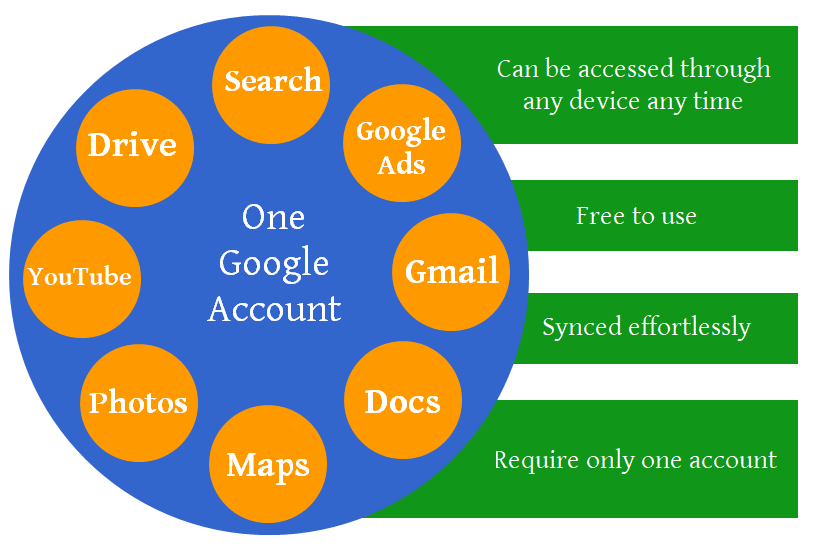
Few companies have such a vast and popular software and app ecosystem, and this is nearly impossible to replicate.
Weaknesses
1. Overdependence on revenue from advertising
Alphabet relies heavily on earnings from Google’s advertising business. In 2020, Alphabet’s Google earned US$146,924 billion or 80.5% of its total revenue purely from advertising. This makes the company very vulnerable to the following changes in the digital advertising market:
- increasing competition;
- query growth rates;
- the evolution of the online advertising market;
- changes in advertising offerings;
- advertising trends;
- user preferences.
Currently, aggregate cost-per-click (CPC) rates (the amount advertisers pay for their advertisements) are falling.
Figure 9. Decline of average CPC prices
| 2015 | 2016 | 2017 | 2018 | 2019 | 2020 |
|---|---|---|---|---|---|
| (11)% | (11)% | (21)% | (25)% | (6)% | (10)% |
Aggregate CPC rates declined by 21%, 25%, 6% and 10% in 2017, 2018, 2019 and 2020, respectively.[1] Therefore, even with the growing overall number of clicks on Google’s sites, Google struggles to maintain the same advertising revenue growth each year. The trend of declining CPC rates will likely continue and Alphabet is therefore at risk of declining revenue growth from its core business.
2. Criticism over patent infringement, copyright infringement, unfair business practices, violation of users’ privacy and tax avoidance
Alphabet’s Google is a giant technology company that attracts a lot of media and competitive attention. The company is often criticized for its operations, policies and actions in the following areas:
- Patent infringement. Google is competing in the technology sector, where patents are involved in every piece of product or software code. In order to successfully develop technology products and software, companies must develop huge patent portfolios or infringe patents and pay associated fees to the patent owners. Google has been accused and found guilty in numerous patent infringement cases, including Vringo v Google, Oracle v Google, Overture v Google, Impact Engine v Google and many others, resulting in the company being legally required to pay hundreds of millions of dollars in damages.[22][23]
- Copyright infringement. Similar to its patent infringements, Google has often infringed copyright laws. Some of the most notable lawsuits Google has been involved in include Oracle v Google and Viacom v Google. Both lawsuits cost the company financially and resulted in negative publicity for Google.
- Unfair business practices. Google has been accused and fined for leveraging its dominant market position over the competitors. The company has been involved in unfair business practices mostly in its search products, android OS and web browser markets. Google unfairly promotes its products over the rivals’ offerings or requires its products to be installed as default on the competitors’ products. Smaller companies have no power to influence these business practices.[24][25]
- Violation of users’ privacy. Google collects, stores and processes all the information it collects about users of its products and services. In some cases, the company doesn’t inform its users about changes in privacy policies or uses the collected information improperly and violates users’ privacy. Usually governments, rather than individuals, fine the company for such violations.
- Tax avoidance. Google uses various schemes to avoid paying more tax in Europe, Australia and some other countries. The company is heavily criticized for these practices and so-called ‘Google tax’ laws are already introduced in countries such as Australia and in Great Britain. These laws will force major corporations to pay appropriate income taxes in countries where they actually earn revenues, rather than transferring funds to lower-tax countries.
Negative publicity damages brand reputation. Most infringements and violations also lead to lawsuits, which result in damages or settlements that have to be paid, and these can potentially run into hundreds of millions or even billions of dollars.
3. Poor user experience of the Android OS due to increasing fragmentation
Google’s Android OS dominates the smartphone market with more than 71.9% global market share (see Figure 3). Such dominance was achieved by providing a free, reliable and well-maintained OS accompanied by a developed ecosystem that most manufacturers weren’t capable of creating for themselves. Therefore, over 90% of all manufacturers chose Android as their primary OS. Currently, Android is on thousands of different device models that are sold worldwide.[26] While this allows Google to serve nearly every niche of the market, it also raises many issues for Android developers and users.
It is becoming increasingly difficult for Android developers to release optimized new applications for so many different smartphone and tablet models. This problem is compounded by the devices also running many different OS versions.
Users also experience issues with Android due to its fragmentation. First, user experience varies across different manufacturers and different models of smartphones because many manufacturers install their own versions of the interface. Each different interface alters the user experience with Android OS, so no user can expect the same experience across every Android device. Secondly, manufacturers and cell phone carriers rather than the Android developer team decide when and what software updates will be installed onto Android phones.
Such a situation places the Android OS in a vulnerable position when new security updates have to be installed quickly. With more than 1 billion new Android devices expected to be released in 2021,[28] Android’s fragmentation problem may become an even more serious issue.
Opportunities
1. Growing market for subscription-based video on demand services
YouTube is the most popular video on demand streaming platform in the world, with more than 2 billion users who spend a collective hundreds of millions of hours watching user-generated content.[29] YouTube’s current strategy is to reach the widest audience possible by providing its service for free.
The platform generates its revenue mainly through displaying advertisements before or during videos. However, that is not currently a profitable business plan, especially when average CPC prices are falling. In order to increase the platform’s revenue and profitability, YouTube started offering a subscription-based services YouTube Premium, a TV subscription service YouTube TV and YouTube Music.
The market for video on demand services is growing. According to the data from Statista, the market is expected to grow by 10.17% annually from 2021 to 2025.[30] It is estimated to grow by around US$40 billion from a projected US$85.887 billion in 2021 to US$126.548 billion by 2025. The market for subscription-based video on demand (SVoD) services will be worth US$71.237 billion in 2021 and will grow even faster than video on demand market.
Figure 11. Video on demand market value growth during 2021-2025 (in US$ billions)
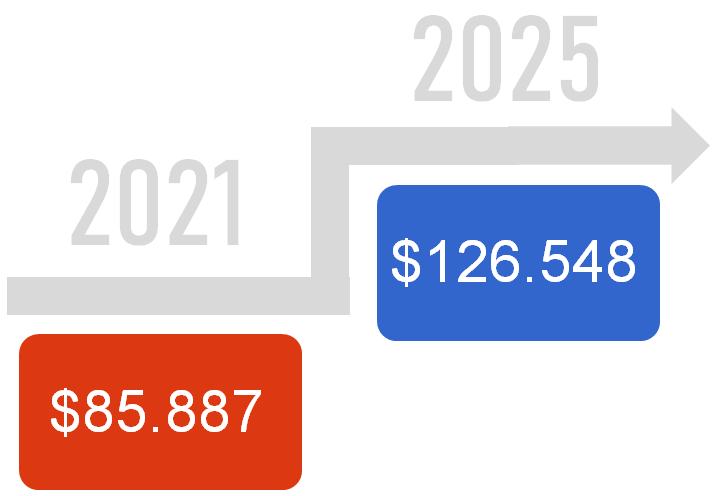
The market for SVoD is huge and Google’s YouTube is well positioned to take advantage of this opportunity with its more than 2 billion existing users. Google’s revenue from YouTube ads grew by US$4.623 billion in 2020.[1] Google other revenues increased by US$4.697 billion in 2020. The growth was primarily driven by Google Play and YouTube non-advertising income. Growth for YouTube non-advertising was primarily driven by an increase in paid subscribers. If we estimate that at least 50% of Google other revenues sales were driven by new YouTube subscriptions, then YouTube’s Premium revenue grew by at least US$2 billion in 2020 alone.
YouTube should push its services more aggressively to take advantage of this growing opportunity. It could also increase the number of its own original movies and TV shows, which would further help the platform to attract more subscribers.
2. Growing demand for artificial intelligence and machine learning tools
Technology companies have been developing artificial intelligence tools for decades now. AI has many applications in all of the industries and makes a promise to solve many of the problems that humans currently can’t.[31] Businesses require smarter machines to help them in day-to-day activities, to facilitate making smarter decisions and to help solving complex problems. Machine learning (ML) is part of AI, which enables AI to learn by using data, statistics and trial and error.[32] The demand for ML tools has significantly increased with big data, when companies were able to collect and store significant amounts of data.
Alphabet and its subsidiary Google heavily invest into both AI and ML. According to the company, those technologies drive the most of the company’s latest innovations and enabled the company to build products that are smarter and more helpful.[1] The company successfully applies its research on AI and ML for its own products. The examples include algorithm to understand natural language, called BERT, Google Assistant and a machine learning platform TensorFlow, among many other tools and products that benefit from the research.[1]
Both markets, the broader AI market and its subset ML market, have huge potential in the future as the research on AI and ML cannot only be applied for Alphabet’s own products, but also to be offered to other businesses as commercial tools and services. IDC forecasts that worldwide revenues for the AI market, including software, hardware, and services, will grow from US$327.5 billion in 2021, to around US$554.3 billion in 2024, growing on average by 17.5% each year.[33]
Figure 13. Worldwide AI software forecast 2020-2024
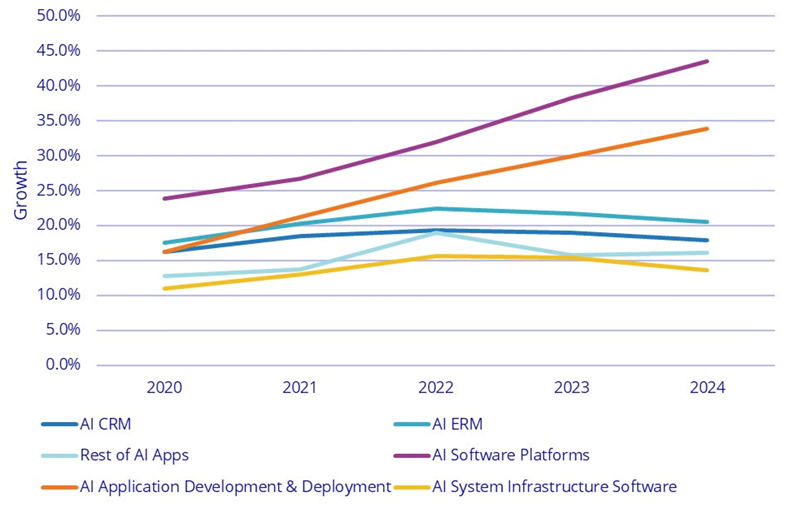
According to this research,[34] ML market is estimated to grow from US$8.43 billion in 2019 to US$117.19 billion by the end of 2027. The key for the ML market growth will be the tools that integrate ML capabilities with analytics-driven solutions. The most important industries for ML will be IT and telecommunications, healthcare, automotive and retail.[34]
Alphabet and Google should use their expertise and research in AI and ML to not only improve their own products, but to develop market ready tools and services for the commercial use. This way the company would be able to gain strong position in the market and would have an opportunity to grow its revenue significantly over the next decade.
3. Edge computing market size will grow to US$15.7 billion by 2025
Edge computing is “a networking philosophy focused on bringing computing as close to the source of data as possible in order to reduce latency and bandwidth use.”[35] The need for edge computing increased after more and more devices started sending their data into the cloud for that data to be processed by AI or for machine learning purposes. The time it takes for the data to be sent to the cloud, processed and retrieved or the massive amount of the data that needs to be sent and retrieved creates latency and bandwidth issues. To solve these problems, many cloud providers, such as Amazon’s AWS, Microsoft’s Azure and Google’s Cloud started offering edge computing services and products.
To overcome bandwidth issues, these companies offer edge infrastructure products. This infrastructure can be installed on private networks and there’s no need for the data from the devices to be sent to the cloud and back for it to be processed. Lightweight AI and ML solutions installed on the edge infrastructure can process the data locally. As for the latency problems (the need for the data to be sent and retrieved almost instantly), a combination of edge servers and 5G devices should offer a good solution.
According to the MarketsandMarkets analysis,[36] the market for edge computing will grow from an estimated US$3.6 billion in 2020, to US$15.7 billion by 2025, growing by 34.1% every year. The main drivers for the edge computing market growth will be an ever-increasing number of connected devices, 5G network and the need for real-time AI responses to the data from those devices.
Figure 14. Edge computing market value growth during 2020-2025 (in US$ billions)
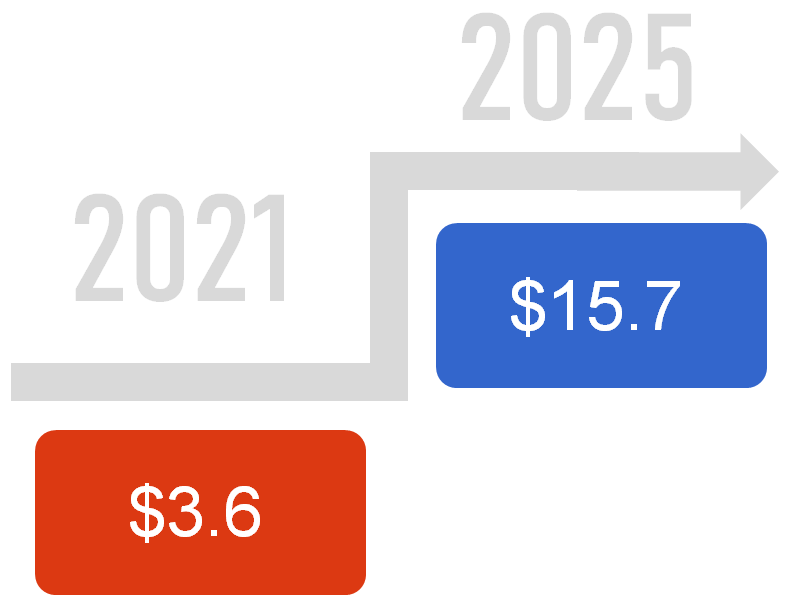
At the moment, Google is trying to strengthen its edge computing solutions with Anthos and edge infrastructure products like Edge TPU, but is still lacking behind its main competitors, Amazon and Microsoft.[37] In order to grow its market share and revenue from edge computing, Google should strengthen its position by offering more various products and solutions and enter into new partnerships with businesses that will have significant need for such services.
4. Wearable medical device market will be worth US$85.6 billion by 2027
Over 444.7 million wearable devices were sold in 2020 alone, representing 28.4% market growth over 2018.[38] IDC forecasts that the market for wearables will grow on average by 12.4% until 2023, reaching 637.1 million units.[39] Out of all wearable devices, the most prominent will be hearables and watches, accounting for about 62.8% and 24.7% of the market respectively.[39]
One of the main factors contributing to this wearable market increase will be the demand for health-related wearables. Wearables are getting more accurate at measuring heart rate, blood pressure, body temperature, stress levels and other health conditions. Various apps combined with wearable data can efficiently and effectively monitor and diagnose your health and help you share that data with your doctors. The market for wearable medical devices will see significant growth in the future. A report from Market Study Report predicts that the global wearable medical devices market will reach US$85.6 billion by 2027.[40]
Figure 15. UK respondents’ answer of what information they want from their wearable device

Last year, Google acquired Fitbit, which controlled 2.9% of the global wearable device market in 2020.[38] This creates a huge opportunity for the company to get into the wearable medical device market. Fitbit has a health focused watch model called Sense, but the company could further improve health related medical devices lineup by introducing more watches and other wearables focused on health. By capturing only 10% market share the company could potentially earn US$8 billion in additional revenue and gain valuable data to further improve its products.
Threats
1. Widespread adoption of advertisement-blocking software
In 2020, Alphabet earned US$146,924 billion or 80.5% of its total revenue solely from advertising. Advertising remains the main source of revenue for the company, which is now threatened by an increasing usage of ad-blocking software
2020 PageFair Adblock Report reveals that ad-blocking software and apps are on the rise, growing by 2.2% in 2019 when compared to the previous year and 36.7% when compared to 2016.[42] The following facts from the Report are a serious threat to Alphabet’s Google:
- Over 763 million devices running ad block as of December 2019;
- Over 236 million people were blocking ads on desktop;
- Over 527 million people were using mobile browsers that block ads by default;
Figure 16. Adblock monthly active users (in millions)
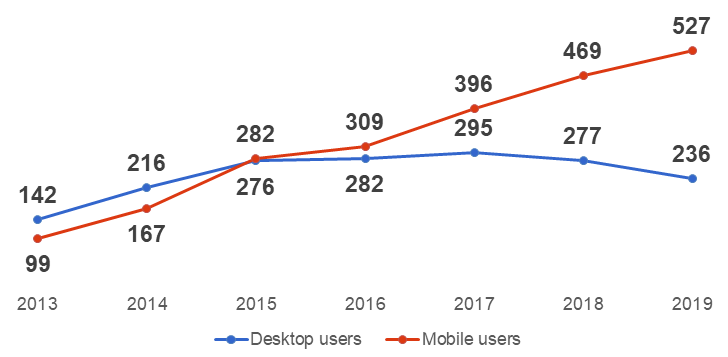
Increasing ad-blocking software usage is threatening Alphabet’s revenue and will likely decrease it in the future. The company itself identifies this threat in its financial report:
“Technologies have been developed that make customized ads more difficult or that block the display of ads altogether and some providers of online services have integrated technologies that could potentially impair the availability and functionality of third-party digital advertising. Failing to provide superior value or deliver advertisements effectively and competitively could harm our reputation, financial condition, and operating results.”[1]
2. The continuing decline of average cost-per-click (CPC) prices
Google’s advertising revenue increased by US$12.113 billion or 9% in 2020. The growth of the company’s advertising revenue depends on two factors: aggregate paid clicks and average CPC prices. Currently, the average CPC prices are declining and the total ad revenue grew only because of the higher-than-average number of clicks.
Figure 17. Growth of aggregate paid clicks
| 2014 | 2015 | 2016 | 2017 | 2018 | 2019 | 2020 |
|---|---|---|---|---|---|---|
| 20% | 22% | 34% | 54% | 62% | 23% | 19% |
Figure 18. Decline of average CPC prices
| 2014 | 2015 | 2016 | 2017 | 2018 | 2019 | 2020 |
|---|---|---|---|---|---|---|
| (5)% | (11)% | (11)% | (21)% | (25)% | (6)% | (10)% |
Alphabet lists various reasons for the decreasing CPC prices, including changes in:
- geographic mix
- device mix
- property mix
- ongoing product changes
- policy changes.
The growth of aggregate paid clicks may slow down over the next few years as more people opt to use ad blocking software and the digital advertising markets are becoming more saturated. Slowing growth of aggregate paid clicks combined with declining CPC prices threatens Google’s future revenue growth from advertising if the company isn’t able to effectively respond to these adverse trends.
3. Increased government investigations and new laws
According to Alphabet, two of the key external threats that will negatively affect the company and its operating margins are increased government investigations, as well as the effects of new or existing laws that could be applied to Google’s operations, products and services. The following statements summarize Alphabet’s concerns:
“We and other companies in the technology industry face increased regulatory scrutiny, enforcement action, and other proceedings. For instance, the U.S. Department of Justice, joined by a number of state Attorneys General, filed an antitrust complaint against Google on October 20, 2020, alleging that Google violated U.S. antitrust laws relating to Search and Search advertising.
Separately, on December 16, 2020, a number of state Attorneys General filed an antitrust complaint against Google in the United States District Court for the Eastern District of Texas, alleging that Google violated U.S. antitrust laws as well as state deceptive trade laws relating to its advertising technology.
Various other regulatory agencies in the United States and around the world, including competition enforcers, consumer protection agencies, data protection authorities, grand juries, inter-agency consultative groups, and a range of other governmental bodies have and continue to review our products and services and their compliance with laws and regulations around the world.
Various laws, regulations, investigations, enforcement lawsuits, and regulatory actions have in the past and may in the future result in substantial fines and penalties, injunctive relief, ongoing auditing and monitoring obligations, changes to our products and services, alterations to our business models and operations, and collateral litigation, all of which could harm our business, reputation, financial condition, and operating results.”[1]
Google and Alphabet have been and continue to be a subject to various governmental regulations and investigations. In 2017, 2018 and 2019 European Commission has found Google guilty of breaking European competition law and has been fined for a total of US$8.7 billion. As mentioned above in Alphabet’s financial report, new antitrust complaints have been opened against the company, which will likely result in more fines for Google and Alphabet.
4. Growing privacy concerns and the possibility of data breaches
Alphabet’s and Google’s main competitive advantage is its massive amount of user information. The company collects, stores, uses and protects that information. In other words, the company retains full control of the data it has and this raises many privacy concerns. If Alphabet isn’t able to ensure the responsible use of data and its security, this will deter current and potential users from using its products and services. Alphabet considers privacy concerns a serious threat to its business, which is revealed in the following company statement:
“Data privacy and security concerns relating to our technology and our practices could damage our reputation, cause us to incur significant liability, and deter current and potential users or customers from using our products and services. Software bugs or defects, security breaches, and attacks on our systems could result in the improper disclosure and use of user data and interference with our users and customers’ ability to use our products and services, harming our business operations and reputation.”[1]
In addition, the increase in cyber-attacks poses an even greater risk of security breaches, potentially revealing sensitive information of Google customers and users. Such data breaches would damage the company’s brand and users would no longer trust Google’s ability to securely collect and store their information.
Privacy concerns combined with a greater possibility of future data breaches are a serious threat that could significantly impact Alphabet’s and Google’s business in the future.
Summary
Alphabet’s Google is one of the most successful global companies for a reason. Its success lies in the company’s innovative culture, acquisition capabilities and product ecosystem. The company should further strengthen its product ecosystem either by developing it inside or by acquiring new businesses. Google has one of the widest software ecosystems in the world and should focus on expanding it. The company has no reason to make significant investments into hardware product ecosystem as its already dominated by other technology companies, like Apple, Samsung and Amazon.
As for the weaknesses, Google should diversify its revenue stream and aim to earn more from software subscriptions, especially YouTube. Alphabet should also diversify from Google, which brings in over 99% of Alphabet’s revenue, by venturing into different industries such as healthcare.
There are many opportunities both Alphabet and Google could venture in. Alphabet should focus on healthcare device market, while Google should pursue the most lucrative software, edge computing, and machine learning market opportunities.
The threats are all well known for Google and the company is prepared to mitigate them or even eliminate them if they’ll threaten the business more seriously.
Sources
- Alphabet, Inc. (2021). Form 10-K for the Fiscal Year Ended December 31, 2020. Available at: https://abc.xyz/investor/static/pdf/20210203_alphabet_10K.pdf?cache=b44182d Accessed March 23, 2021
- eMarketer (2020). Digital Ad Spending by Industry 2020. Available at: https://www.emarketer.com/content/digital-ad-spending-by-industry-2020 Accessed March 23, 2021
- eMarketer (2020). How Has the Forecast for Triopoly vs. Other Ad Revenues in the US Changed? Available at: https://www.emarketer.com/chart/240190/how-has-forecast-triopoly-vs-other-ad-revenues-us-changed-of-us-digital-ad-spending-2020 Accessed March 23, 2021
- eMarketer (2020). Global Digital Ad Spending Update Q2 2020. Available at: https://www.emarketer.com/content/global-digital-ad-spending-update-q2-2020 Accessed March 23, 2021
- Facebook, Inc. (2021). Form 10-K for the Fiscal Year Ended December 31, 2020. Available at: http://d18rn0p25nwr6d.cloudfront.net/CIK-0001326801/4dd7fa7f-1a51-4ed9-b9df-7f42cc3321eb.pdf Accessed March 23, 2021
- StatCounter (2021). Desktop Search Engine Market Share Worldwide. Available at: https://gs.statcounter.com/search-engine-market-share/desktop/worldwide Accessed March 23, 2021
- StatCounter (2021). Mobile Search Engine Market Share Worldwide. Available at: https://gs.statcounter.com/search-engine-market-share/mobile/worldwide Accessed March 23, 2021
- StatCounter (2021). Mobile Operating System Market Share Worldwide. Available at: https://gs.statcounter.com/os-market-share/mobile/worldwide Accessed March 23, 2021
- Crunchbase (2021). Alphabet. Available at: https://www.crunchbase.com/organization/alphabet Accessed March 23, 2021
- Crunchbase (2021). Microsoft. Available at: https://www.crunchbase.com/organization/microsoft Accessed March 23, 2021
- Crunchbase (2021). Apple. Available at: https://www.crunchbase.com/organization/apple Accessed March 23, 2021
- Crunchbase (2021). Amazon. Available at: https://www.crunchbase.com/organization/amazon Accessed March 23, 2021
- Crunchbase (2021). Facebook. Available at: https://www.crunchbase.com/organization/facebook Accessed March 23, 2021
- Amazon.com, Inc. (2021). Form 10-K for the Fiscal Year Ended December 31, 2020. Available at: https://d18rn0p25nwr6d.cloudfront.net/CIK-0001018724/336d8745-ea82-40a5-9acc-1a89df23d0f3.pdf Accessed March 23, 2021
- Microsoft Corporation (2021). Form 10-K for the Fiscal Year Ended June 30, 2020. Available at: https://microsoft.gcs-web.com/static-files/4e7064ed-bbf7-4140-a8cb-79aba77421b9 Accessed March 23, 2021
- Apple Inc. (2021). Form 10-K for the Fiscal Year Ended September 26, 2020. Available at: http://d18rn0p25nwr6d.cloudfront.net/CIK-0000320193/7b5717ca-6222-48e6-801c-9ea28feeef86.pdf Accessed March 23, 2021
- U.S. Patent and Trademark Office (2021). All Technologies (Utility Patents) Report. Available at: https://www.uspto.gov/web/offices/ac/ido/oeip/taf/all_tech.htm Accessed March 23, 2021
- Forbes (2021). The World’s Most Valuable Brands. Available at: https://www.forbes.com/the-worlds-most-valuable-brands/ Accessed March 23, 2021
- Interbrand (2021). Best Global Brands. Available at: https://interbrand.com/best-global-brands/ Accessed March 23, 2021
- Alphabet, Inc. (2021). Form 10-K for the Fiscal Year Ended December 31, 2016. Available at: https://abc.xyz/investor/static/pdf/20161231_alphabet_10K.pdf?cache=2c695a9 Accessed March 23, 2021
- Alphabet, Inc. (2021). Form 10-K for the Fiscal Year Ended December 31, 2018. Available at: https://abc.xyz/investor/static/pdf/20180204_alphabet_10K.pdf?cache=11336e3 Accessed March 23, 2021
- Cleland, S. at Iam (2020). Supreme Court could signal time’s up for Google’s anti-competitive IP infringement. Available at: https://www.iam-media.com/litigation/supreme-court-could-signal-times-googles-anti-competitive-ip-infringement Accessed March 23, 2021
- Bloomberg (2019). Impact Engine Secures Key Win in Patent Infringement Lawsuit Against Google. Available at: https://www.bloomberg.com/press-releases/2019-12-17/impact-engine-secures-key-win-in-patent-infringement-lawsuit-against-google Accessed March 23, 2021
- Kalogeropoulos, L. (2021). Finally act against Google’s unfair competition practices. Available at: https://www.openinternetproject.net/news/99-finally-act-against-google-s-unfair-competition-practices-en-translation-article-in-le-figaro Accessed March 23, 2021
- Deutsche Welle (2021). Companies plead with EU regulators for action on Google. Available at: https://www.dw.com/en/google-antitrust-eu-european-union/a-55623857 Accessed March 23, 2021
- GSM Arena (2020). All mobile phone brands. Available at: http://www.gsmarena.com/makers.php3 Accessed March 23, 2021
- StatCounter (2021). Android Version Market Share Worldwide. Available at: https://gs.statcounter.com/os-version-market-share/android Accessed March 23, 2021
- IDC (2021). Smartphone Shipments Return to Positive Growth in the Fourth Quarter Driven by Record Performance by Apple, According to IDC. Available at: https://www.idc.com/getdoc.jsp?containerId=prUS47410621 Accessed March 23, 2021
- YouTube (2020). Statistics. Available at: https://www.youtube.com/yt/press/statistics.html Accessed March 23, 2021
- Statista (2021). Video-on-Demand. Available at: https://www.statista.com/outlook/dmo/digital-media/video-on-demand/worldwide Accessed March 23, 2021
- Google (2021). Bringing the benefits of AI to everyone. Available at: https://ai.google/about/ Accessed March 23, 2021
- Built In (2021). Machine Learning. Available at: https://builtin.com/machine-learning Accessed March 23, 2021
- IDC (2021). IDC Forecasts Improved Growth for Global AI Market in 2021. Available at: https://www.idc.com/getdoc.jsp?containerId=prUS47482321 Accessed March 23, 2021
- Fortune Business Insights (2020). Machine Learning Market Size, Share & COVID-19 Impact Analysis. Available at: https://www.fortunebusinessinsights.com/machine-learning-market-102226 Accessed March 23, 2021
- Cloudflare (2021). What is edge computing? Available at: https://www.cloudflare.com/learning/serverless/glossary/what-is-edge-computing/ Accessed March 23, 2021
- MarketsandMarkets (2020). Edge Computing Market. Available at: https://www.marketsandmarkets.com/Market-Reports/edge-computing-market-133384090.html Accessed March 23, 2021
- Sacolick, I. at InfoWorld (2020). Amazon, Google, and Microsoft take their clouds to the edge. Available at: https://www.infoworld.com/article/3575071/amazon-google-and-microsoft-take-their-clouds-to-the-edge.html Accessed March 23, 2021
- IDC (2021). Consumer Enthusiasm for Wearable Devices Drives the Market to 28.4% Growth in 2020, According to IDC. Available at: https://www.idc.com/getdoc.jsp?containerId=prUS47534521 Accessed March 23, 2021
- IDC (2020). Worldwide Wearables Market Forecast to Maintain Double-Digit Growth in 2020 and Through 2024, According to IDC. Available at: https://www.idc.com/getdoc.jsp?containerId=prUS46885820 Accessed March 23, 2021
- Market Study Report, LLC. (2020). Global wearable medical devices market size to reach USD 85.6 Billion by 2027. Available at: https://www.globenewswire.com/news-release/2020/11/19/2129810/0/en/Global-wearable-medical-devices-market-size-to-reach-USD-85-6-Billion-by-2027.html Accessed March 23, 2021
- PwC (2016). The Wearable Life 2.0. Available at: https://www.pwc.com/us/en/industry/entertainment-media/assets/pwc-cis-wearables.pdf Accessed March 23, 2021
- Blockthrough (2020). Growth of the Blocked Web 2020 PageFair Adblock Report. Available at: https://s3.amazonaws.com/media.mediapost.com/uploads/2020-PageFair_Blockthrough-Adblock-Report.pdf Accessed March 23, 2021


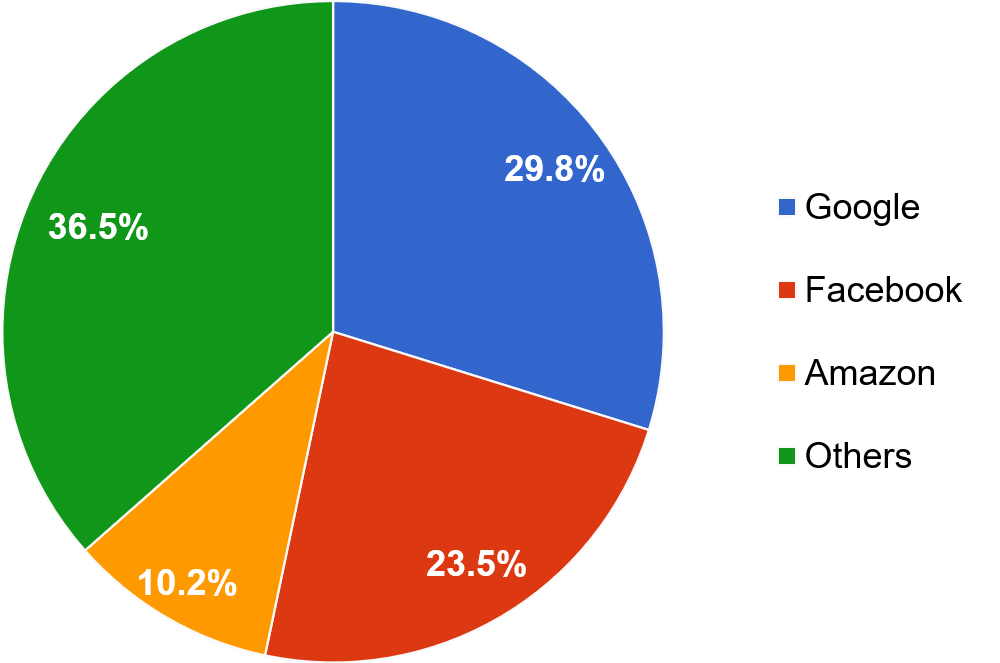 Source: eMarketer[2][3]
Source: eMarketer[2][3]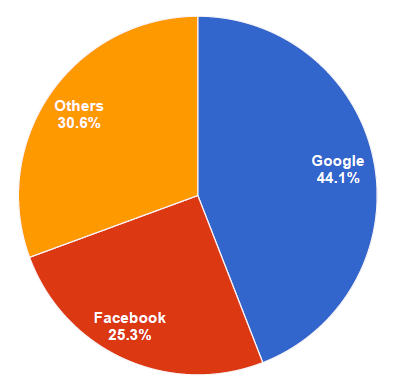
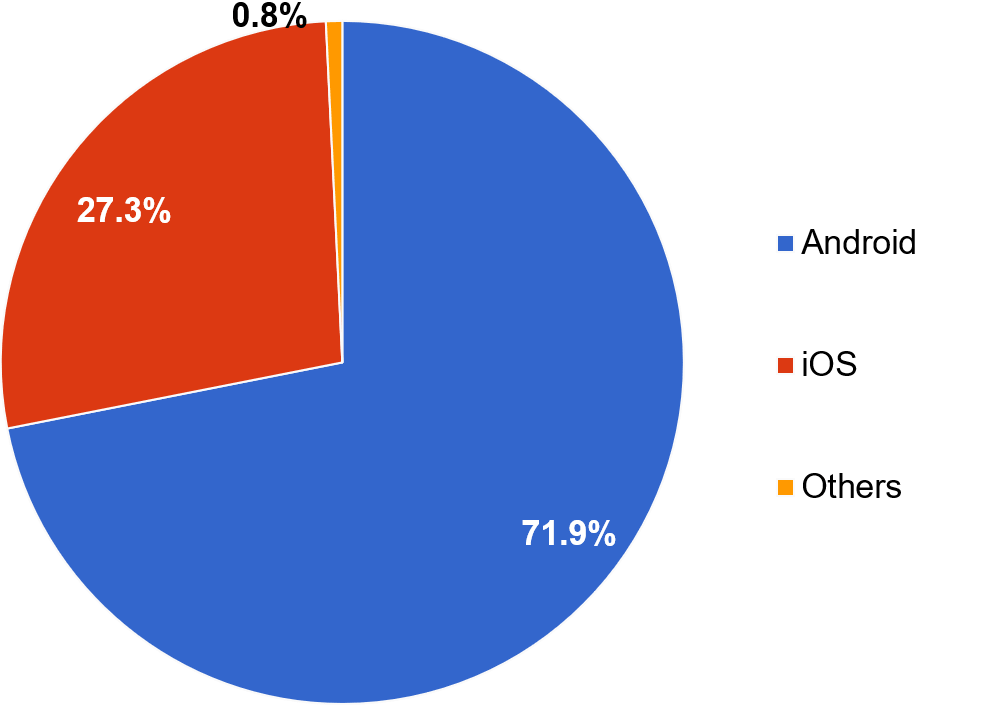 Source: StatCounter[8]
Source: StatCounter[8]